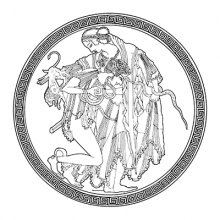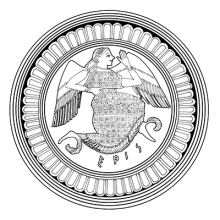
You are here
Episode 1: An Apple for a Goddess
Story summary
Teaching activities
- Starting points
- Follow-up
- Further activities
Offer some background information about the origin of this story (see ![]() Why this story? and
Why this story? and ![]() Sources for War with Troy) and encourage learners to remember questions to ask at the next pause point. Begin with something like this: “Listen carefully to this first episode of War with Troy. The whole story is told in twelve episodes. Today we’ll be listening to Episode 1, told by the storyteller Daniel Morden. Here are two questions to think about while you are listening:
Sources for War with Troy) and encourage learners to remember questions to ask at the next pause point. Begin with something like this: “Listen carefully to this first episode of War with Troy. The whole story is told in twelve episodes. Today we’ll be listening to Episode 1, told by the storyteller Daniel Morden. Here are two questions to think about while you are listening:
- Daniel will tell us about two brothers, one giving advice to the other. After the episode can you say who these brothers are, and what the advice is?
- Three gods and a sea-nymph are described through the appearance of their eyes. Which immortals are also described in this way, and how are their eyes described?
“I am going to play the audio up to the end of the first track — about six minutes. Listen carefully. Don’t try to answer the questions until Daniel has finished speaking and we can talk about it together.” Alternatively, you may prefer to let learners listen with more open questions in mind e.g. a general question about the names of the main characters, whether they are mortal or immortal, whether this story is like any other they have heard.
- Discuss the relationship between Zeus and Poseidon. (They are brothers.)
- Did Poseidon give good advice? At this point in the story can you actually tell?
- Which instruments can you hear at the beginning of the episode? (A gong and a drum.) How does this music make you feel? What kind of story do you expect to hear? Why?
- At the beginning Daniel, the storyteller, gives an instruction. What is it? (He tells us to imagine.) Why does he repeat this? What effect does it have on you?
- Discuss the illustration,
![[pdf] [pdf]](/sites/default/files/pdf_icon.png) Peleus and Thetis, which shows an ancient Greek artist’s representation of Thetis’ transformations. Is that how you imagined Thetis? Why do you think the setting and Thetis herself are not described in detail in the story? What reason could the storyteller have for this? (It allows listeners to use their imagination.)
Peleus and Thetis, which shows an ancient Greek artist’s representation of Thetis’ transformations. Is that how you imagined Thetis? Why do you think the setting and Thetis herself are not described in detail in the story? What reason could the storyteller have for this? (It allows listeners to use their imagination.) - Some of the immortals are described with reference to their eyes only. What the eyes of each god/goddess are like? (Owl-eyed Athene, ox-eyed Hera, red-eyed Ares, the pebble eyes of Thetis.) What do we learn about these gods from these brief descriptions?
- Where else have you heard of an apple being used to trick or tempt someone? (Adam and Eve/Snow White.)
- Show the class the illustration,
![[pdf] [pdf]](/sites/default/files/pdf_icon.png) Eris. What is the artist trying to suggest about her character? (Eris is always on the move: she has both wings and winged feet, and she is shown in a running pose.) Is it a fair portrayal of the goddess of arguing? Ask the class to draw their own picture of Eris.
Eris. What is the artist trying to suggest about her character? (Eris is always on the move: she has both wings and winged feet, and she is shown in a running pose.) Is it a fair portrayal of the goddess of arguing? Ask the class to draw their own picture of Eris. - Can anybody recall the wedding gifts and who gave them? (Athene, a spear; Ares, a golden breastplate; Aphrodite, the ring; Poseidon, four horses; Zeus, the Myrmidons; Hades, the black funeral urn.)
- How do things change at the wedding after the gift of the apple? (The dancing is no longer graceful, gods and mortals are no longer in harmony, the music is drowned out by the sound of argument.)
- What prophecies are made about Achilles? (He will be greater than his father; he will die young.)
- Describe and/or draw the ring that Achilles gives to Patroclus. How did Thetis acquire this ring? (It was given to her as a wedding present by Aphrodite.)
Zeus intervenes to make Thetis and Peleus marry. Discuss reactions to this.
What sort of power do and should the gods have over the mortals in this story?
Visual aids
Peleus and Thetis
Based on a cup by Peithinos, c. 500 BC. Antikenmuseum, Berlin-Charlottenburg.
Peleus seems to kneel before Thetis rather than wrestle with her. He does not appear too troubled by the lion on his back or the snakes entwining themselves round his arm and leg. Though these animals represent the different shapes that Thetis adopted to avoid Peleus’ grasp, Peleus’ sword remains in its scabbard: he does not want to harm her.

Eris
Based on Little Master cup, c. 560 BC. Antikenmuseum, Berlin-Charlottenburg.
Eris, the goddess of arguing and trouble, is shown in the conventional pose of someone running at full speed. Is she always dashing about, causing mischief? She wears winged sandals, like Hermes. Her name is written below in Greek script, filling out the circular space available to the artist.
